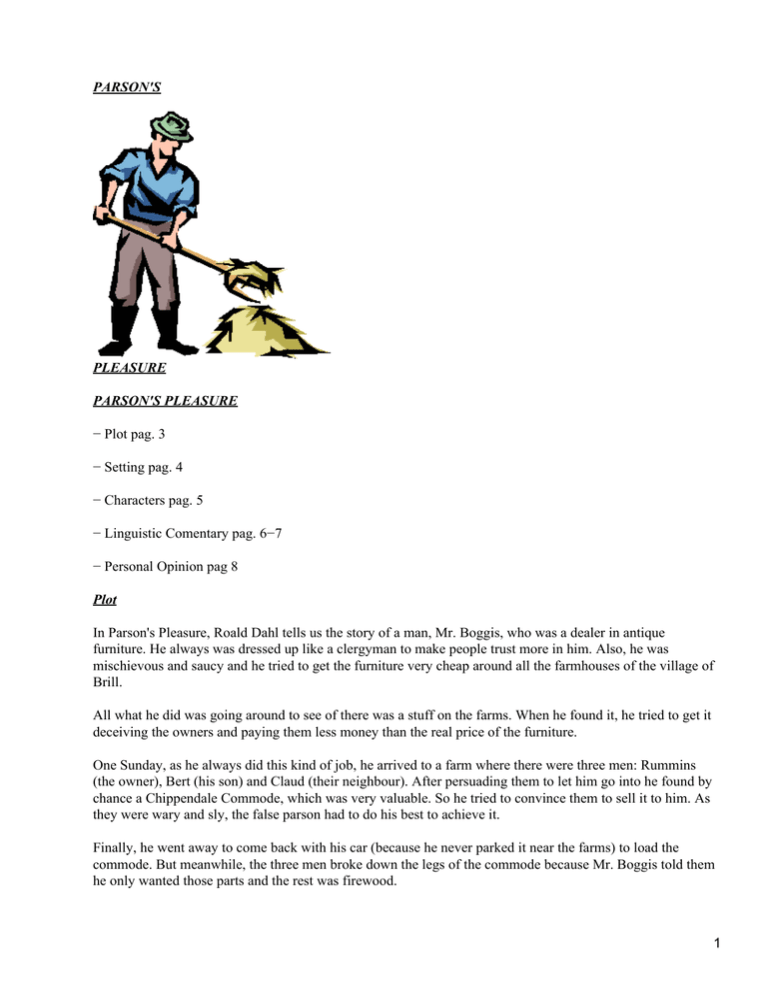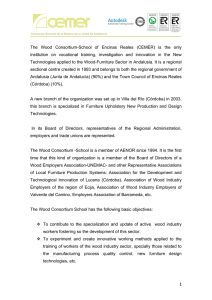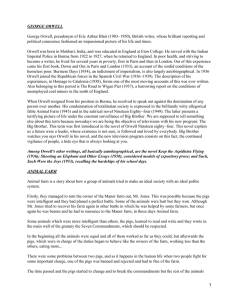Parson's Pleausure; Roald Dahl
Anuncio

PARSON'S PLEASURE PARSON'S PLEASURE − Plot pag. 3 − Setting pag. 4 − Characters pag. 5 − Linguistic Comentary pag. 6−7 − Personal Opinion pag 8 Plot In Parson's Pleasure, Roald Dahl tells us the story of a man, Mr. Boggis, who was a dealer in antique furniture. He always was dressed up like a clergyman to make people trust more in him. Also, he was mischievous and saucy and he tried to get the furniture very cheap around all the farmhouses of the village of Brill. All what he did was going around to see of there was a stuff on the farms. When he found it, he tried to get it deceiving the owners and paying them less money than the real price of the furniture. One Sunday, as he always did this kind of job, he arrived to a farm where there were three men: Rummins (the owner), Bert (his son) and Claud (their neighbour). After persuading them to let him go into he found by chance a Chippendale Commode, which was very valuable. So he tried to convince them to sell it to him. As they were wary and sly, the false parson had to do his best to achieve it. Finally, he went away to come back with his car (because he never parked it near the farms) to load the commode. But meanwhile, the three men broke down the legs of the commode because Mr. Boggis told them he only wanted those parts and the rest was firewood. 1 The story ended up with the coming back of the parson to the farm, but there was a open final. The story is written on third person by a narrator who is telling it from outside, in other words, has nothing to do with the characters or the action. The structure is linear, at the beginning, it introduces you the main character, Mr. Boggis, and then it started to tell us the story to the end. Also there is two little flashbacks to report us how he found his first bargain and how he convinced a woman to sell him a pair of chairs. As we have refered to before, the final is wide open to let you think about your own interpretation. Setting The story is become localized in England about 1950 or 1960. It´s summer, Mr. Boggis is to make for the top of Brill Hill, in the village of Brill. From drives up through the village to the other side of the hill. From there he spotts five farms and one big white Georgian house. Now, there are ten possibles ones in all. Mr. Boggis makes it because he draws. He is a dealer in antique furniture in the King´s Road, Cheslsea. All events happens on Sundays. During the past few years, Mr. Boggis had achieved considerable fame among his friends in the trade by his ability to produce unusual and often quite rare items. Everything begining on a certain Sunday afternoon nearly nine years before, while he was driving in the country. He travels through all counties of London, to look for antique furnitures. Firstly Sevenoak, where he gets two chairs paying something less than a twentieth of their value. In another farmhouse it was a large halftimbered brick building of considerable age. In there, there was a semicircular card− table in mahogany the style of Hepplewhit, built around 1780. The next farm was sutuated some way bacd in the fields. This place was a good deal smaller than the last. It looked rambling and dirty, the sheds were in bad repair. All what he saw in this farm was a piece of furniture. Here, it´s where the most part of the story is developed. Mr. Boggis tries to get the piede of furniture by lies, swindles... but finally, the people, who Mr. Boggis wanted to deceive, are who deceive Mr. Boggis. The Characters Cyril Boggis: is the main character of the story. He's a small fat−legged man with a round and rosy face. His eyes are large and brown giving an impression of gentle imbecility. He smokes and likes drinking beer. Boggis is a dealer in antique furniture and he probably knows as much about French, English and Italian furniture as anyone else in London. He has his own shop and showroom in the King's Road, Chelsea. 2 Therefore we can say that is a talented salesman who knows what the client want. He's comfortably off and perhaps has became grave and charming for the aged, obsequious for the rich, sober for the godly, masterful for the weak, mischievous for the widow and arch and saucy for the spinster. Obviously he's got a good taste and loves the work of the great eighteenth−century English designers. But he's not a normal dealer because he dresses up like a fellow and cheats people telling them that he's the President of the Society for the Preservation of Rare Furniture. And when he dresses as a clergyman to make the deals, he does with a black suit and the usual parson's dog−collar round his neck, and on his head a soft black hat. He also carried an old oak walking stick. Rummins: an old and stumpy man with a wide frog mouth and small pig and shifty eyes, he also has several broken teeth. He's the owner of a farm in Buckinghamshire, about ten miles from Oxford. About his character and the character of the next two men I can say they are very suspicious and wary and sly. Bert: is Rummins' son. He's tall and young, with odd eyes, but appeared to have something wrong with one of them. Claud: a shortish flat−faced man, with two large slow eyes, and with a narrow corrugates brow and immensely broad shoulders. He's a farmer who has two dogs and lives near Rummins farm. Old Woman: a gigantic woman with a set of enormous, slightly yellow teeth, dressed in riding−breeches that smokes and has the odour of stables and horse manure. She is very rude and suspicious but kind anyway. Linguistic Comentary In this section we are going to study the syntax, the semantics (semantic fields) and the morphology. In the beginning, we can see the title: Parson's pleasure. An opening antithesis that shows us the several puns that the tale will contain. This first contrast shows the mixture between religion and lust, pleasure... Parson belongs to religion the opposite Pleasure means lust, enjoyment At the beginning of the tale we find: Mr. Boggis was driving.... Roald Dahl uses this surname referring to the adjective bogus. This is one of the best examples of the puns we can find in the text. He plays with the morphology (Boggis− bogus). Why bogus? Because this adjective perfectly describes the personality of the false parson since the main character is not genuine. He is intentionally false, pretends to be what he is not, misleads people with his dialogue and he is artificial. For this reason the author calls him, in a hidden way, bogus. If we look for the way the author tells the story, we will find long descriptions of landscape as when he describes the hawthorn which was exploding white and pink and red along the hedges and the primroses were growing underneath in little clumps, and it was beautiful He also takes his time when describing the pieces of furniture the false parson finds in his way. 3 He uses about twenty−five lines in order to describe only one little table. He shows us all the details the table could have ending with: have been executed only by Thomas Chippendale himself, with his own hands, at the most exalted period in his career. Regarding semantic fields, we can mainly find two examples. The first is about the countryside, where Roald Dahl talks about nature (flowers, country, air, animals, different kind of smells...), farms, farmers, houses we can find outside cities.... The second example of semantic field is about furniture where we are told about different kinds of tables, chairs, the designers who once made these pieces, the material they are made of, the shapes we can find, the different parts of the pieces, the period when they were made, for example Victorian's time or Queen Anne. In the syntax, we can find a lot of adjectives that are used to enrich the tale. The sentences are not very long but we can find exceptions when the clergyman thought about the money he could get or when he argues with the owners about the prices of the pieces of furniture. Finally, from my personal viewpoint the reading has been quite easy except for the words that are related to the furniture. Therefore it has been a fast−paced tale full of ingenious words with double meaning or hidden meanings in words that make the reading much more fun. Personal Opinion For all of us, Parson's Pleasure has been an incredible and amazing story. We have enjoyed reading it very much. All the characters are well−built and, specially Rummins, Bert and Claud. At first sight you can think they are silly or ignorant (so they are in a kind of way), but all what they do during the story is as a result of Mr. Boggis' words. He wanted to deceive them taking the commode away and paying them less than it cost. Mr. Boggis is a man who never minds how to act or what to say if he gets all he wants. So we think he got what he deserved. The descriptions of the characters (their physical appearance, their thoughts, even a little flashback in Mr. Boggis life at the beginning of the story) are very long in order to know themselves better. Because of that, you can understand what's going to happen next. The plot is exciting and catches you at all from its middle, when Mr. Boggis finds out the commode in Rummin's farm, to the end, when the parson comes back to carry on the commode with him. For this reason the ending is socking and you can't imagine that this can happen. If Mr. Boggis hadn't been such an ambitious man, all this wouldn't have passed. But then, the plot wouldn't be so interesting. To sum up, we all agree that Parson's Pleasure is, without any doubt, one of the best stories of Kiss, Kiss. 1 4

